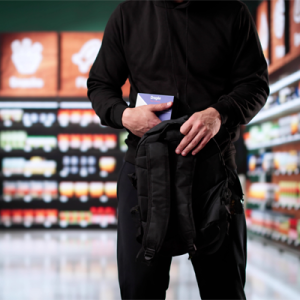Retail Theft on the Rise: What CPG Brands Can Do About It
 Retail theft surges across Canadian stores in 2025, impacting everything from grocery chains to pharmacies to big box retailers. The videos are emerging weekly, bandits of gangs storming retail stores, grabbing whatever they want.
Retail theft surges across Canadian stores in 2025, impacting everything from grocery chains to pharmacies to big box retailers. The videos are emerging weekly, bandits of gangs storming retail stores, grabbing whatever they want.
The rise in organized retail crime (ORC) and opportunistic theft is no longer just a retailer problem — it’s a CPG brand problem too.
When products disappear off shelves without selling, CPG brands suffer lost sales, damaged brand visibility, and even strained retailer relationships.
Here’s how innovative CPG manufacturers are adapting their merchandising to respond to the new reality:
- Prioritize High-Theft Risk Assessments
Not every product is at equal risk. Brands are now:
- Identifying high-theft SKUs (high resale value, small size, easy concealment).
- Partnering with retailers to flag and monitor vulnerable categories.
- Adjusting merchandising strategies based on risk profiles.
Understanding your theft “hot zones” is the first step to mitigating losses.
- Adjust In-Store Merchandising
Brands are working with retailers to:
- Move high-theft items closer to checkout zones.
- Integrate locked peg hooks for small, expensive items.
- Use dummy packaging where necessary (customer requests real product at checkout).
Creative placement and protection mechanisms can reduce temptation and opportunity.
- Improve Packaging to Deter Theft
Some brands are revisiting packaging to:
- Increase package size (harder to conceal).
- Incorporate anti-theft tags discreetly into designs.
- Use “multi-pack only” formats for certain high-value goods.
Packaging can be a robust frontline defence without sacrificing shelf appeal.
- Strengthen Retailer Collaboration
Open communication with retail partners is critical. Leading CPGs:
- Share data about suspicious activity or trends noticed at the store level.
- Collaborate on loss prevention initiatives.
- Support store staff with training materials about handling their products.
When CPG brands act as partners, they build loyalty even during tough times.
- Innovate with Technology
Some brands are piloting innovative shelf technology, including:
- Real-time shelf weight sensors.
- Camera-based inventory tracking.
- Smart labels that alert when a product is removed improperly.
While expensive to scale today, tech investments could be vital for high-theft, high-margin products.
Real-World Example: Low-Tech, High-Impact Solution
One Canadian snack brand reduced theft by 38% at a major retailer by moving high-theft items into a “bundle buy” program — pairing them with larger, lower-risk SKUs in a single package.
Sales remained strong, while theft dropped significantly.
Key Takeaways for CPG Brands
- Accept that theft is now a merchandising issue, not just a retailer issue.
- Collaborate early and often with retail partners.
- Design merchandising and packaging with risk mitigation in mind.
- Embrace tech and low-tech solutions where they make sense.
Retail theft isn’t going away — but brands that adapt quickly, creatively, and collaboratively will protect their shelf presence, retailer relationships, and revenue.
In 2025, smart merchandising isn’t just about selling but securing.
For more information about smart merchandising, please visit www.marketsupport.ca.
« Back to Blog